Kids Helping Kids
KidsHelpingKids
KidsHelpingKids
- No tags were found...
Create successful ePaper yourself
Turn your PDF publications into a flip-book with our unique Google optimized e-Paper software.
These questions will engage students to further understand that relational aggression<br />
is the use of relationships to hurt others. Tell the class that over the next few weeks,<br />
all forms of covert (hidden) aggression, with a special emphasis on relational<br />
aggression, will be discussed.<br />
Ask the students:<br />
• Has anyone in this classroom ever experienced or seen others involved in<br />
relational aggression?<br />
Allow for students to share stories as time permits; emphasize that NO NAMES<br />
should be used. If no student volunteers to tell a story, you can relate a personal<br />
experience or refer to the role playing cards in lesson 4.<br />
If there is time, pass out survey sheets to all children and ask them to complete the<br />
survey with yes/no responses. Let all children know that their responses are<br />
confidential and they should not put their names on them<br />
Collect the surveys and shuffle responses. Redistribute surveys so that each child has<br />
someone else’s survey. Read three or four of the questions out loud and ask each<br />
child to stand if they have a common answer that illustrates relational aggression.<br />
Point out to the class that this is a way to see how different types of aggression have<br />
affected our class.<br />
Closure:<br />
1. Ask students to respond to the essential question.<br />
2. Revisit the buttons and discuss the fact that only some students had them. Ask the<br />
class: How did it feel if you did not get one? How did you feel if you did receive one?<br />
3. Relate this example of exclusion to relational aggression. For example, exclusion,<br />
being different, being singled out because of how you look, etc.<br />
4. Pass out a button to everyone to show unity and a commitment to helping and<br />
actively supporting each other in the classroom and the school.<br />
5. Students can write responses on Reflection Activity 1 OR work in groups of five<br />
to discuss the answers and then come together to share them in the larger group.<br />
©2006 The Ophelia Project ®<br />
<strong>Kids</strong> <strong>Helping</strong> <strong>Kids</strong> - 28


